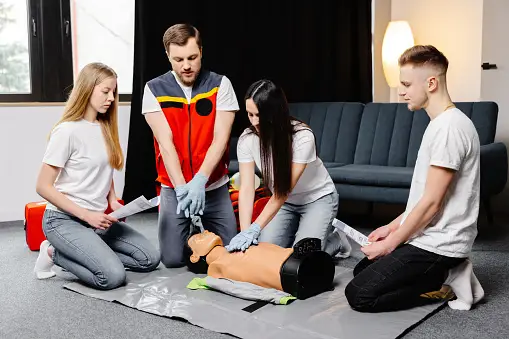What is Taught During Lifeguard Training?
Lifeguard training is crucial for ensuring safety at pools, beaches, and other aquatic environments. This training covers a wide range of skills and knowledge areas. Each aspect of the training prepares individuals to handle emergencies and prevent accidents.
Basic Water Safety
Understanding Water Risks
Lifeguard courses start with basic water safety. Trainees learn about the risks associated with different water environments. They understand how tides, currents, and waves work. They also learn how to identify dangerous water conditions.
Personal Safety Measures
Lifeguards must prioritize their safety. Training includes how to protect oneself while performing rescues. This involves using flotation devices and knowing personal limits.
Rescue Techniques
Types of Rescues
Lifeguards learn several rescue techniques. They are trained in swimming rescues, reaching assists, and using rescue equipment. Each method is suited to different scenarios. Swimming rescues are used when a victim is far from safety. Reaching assists are for victims near the edge of a pool or shoreline.
Using Rescue Equipment
Trainees learn to use various rescue tools. These include rescue tubes, boards, and rings. They practice with these tools in different situations. Knowing how to use them effectively is crucial for quick and safe rescues.
First Aid and CPR
Basic First Aid
Lifeguard training includes basic first aid. Trainees learn how to treat cuts, bruises, and other minor injuries. They also learn to handle more serious conditions like broken bones and heat exhaustion.
CPR and AED
Cardiopulmonary resuscitation (CPR) is a vital skill. Lifeguards are trained to perform CPR on adults, children, and infants. They also learn to use an automated external defibrillator (AED). This training is critical for responding to cardiac emergencies.
Surveillance Techniques
Monitoring Techniques
Lifeguards must constantly monitor their assigned areas. Training teaches them how to scan effectively. They learn patterns and techniques to ensure no part of the pool or beach goes unobserved.
Identifying Distressed Swimmers
Spotting a swimmer in distress is a key skill. Lifeguards are trained to recognize the signs of someone struggling in the water. This includes observing body language and movements. Quick identification can prevent drownings and other emergencies.
Emergency Action Plans
Developing Emergency Plans
Lifeguard classes emphasize the importance of having an emergency action plan (EAP). Trainees learn to develop and implement these plans. An EAP outlines the steps to take during various emergencies. This ensures a coordinated and efficient response.
Communication Skills
Effective communication is crucial during emergencies. Lifeguards are trained to communicate with each other and with emergency services. They learn the appropriate use of whistles, hand signals, and radios.
Physical Fitness
Strength and Stamina
Lifeguard training includes physical fitness tests. Trainees must demonstrate strength and stamina. They participate in swimming drills and endurance tests. Physical fitness is essential for performing rescues and handling emergencies.
Regular Fitness Maintenance
Lifeguards are encouraged to maintain their fitness. Ongoing exercise routines are recommended. This helps ensure they remain capable of performing their duties effectively.
Legal and Ethical Responsibilities
Understanding Legal Duties
Lifeguards must be aware of their legal responsibilities. Training covers the legal aspects of their role. This includes understanding liability and duty of care. Lifeguards learn the importance of adhering to safety protocols to avoid legal issues.
Ethical Conduct
Ethical behavior is emphasized in lifeguard courses. Trainees learn the importance of professionalism and integrity. They are taught to respect all individuals and handle situations with fairness.
Advanced Lifeguard Skills
Specialized Training
Some lifeguard courses offer advanced training. This includes skills like scuba diving and open water rescues. These advanced skills are necessary for specific environments like oceans or large lakes.
Team Coordination
Lifeguards often work in teams. Training includes team coordination exercises. Lifeguards learn to work together effectively. This is crucial for handling large-scale emergencies.
Final Word
Lifeguard training is comprehensive and rigorous. It covers a wide range of skills from basic water safety to advanced rescue techniques. Lifeguards must be prepared for any situation. The American Lifeguard Association offers excellent resources for those interested in lifeguard certification.
To find “lifeguard classes near me” or to learn more about “lifeguard certification”, consider reaching out to local training centers. Proper training ensures the safety of both lifeguards and the public.






